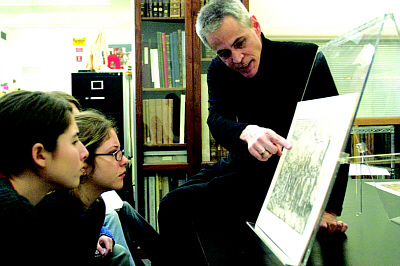JHU Course Catalog: History of Early Modern
Printmaking

History of Early Modern
Printmaking holds its Wednesday class in the print room of
the BMA, which owns one of the country's most comprehensive
collections of works on paper. Here, Walter Melion shows
students a piece by Lucas van Leyden.
PHOTO BY HPS/WILL KIRK
|
Editor's note: This is the second in an occasional
series of articles dropping in on interesting classes
throughout the university's eight academic divisions. To
read about the anthropology class Do You Want Fries With
That? go to
www.jhu.edu/~gazette/
2004/01mar04/01course.html.
By Amy Cowles
Homewood
The course: History of Early Modern Printmaking.
Focusing on woodcuts, engraving and etching, this course
studies how mechanical reproduction changed the way artists
put their ideas to paper between the 15th and 17th
centuries. Beginning with the origins of woodcut and
engraving in the early 15th century, students examine how
print technologies related to the older methods they
replaced, like painting in oils and tempera and drawing
with metalpoint, lead, charcoal and other kinds of
styluses. One of the central issues considered in the
course is the use of prints to tell archetypal stories. A
week each is devoted to the workshops of Durer, Lucas van
Leyden, Marcantonio Raimondi, the Carracci, Hendrick
Goltzius and Rembrandt. It's a small lecture designed for
undergraduates, but some graduate students are also
enrolled. The course meets three times a week, including a
weekly session in the print room at the Baltimore Museum of
Art adjacent to the university's Homewood campus. 3
credits. Department of the History of
Art.
The instructor: Department chair Walter S. Melion,
who specializes in northern Renaissance and baroque art,
with an emphasis on Netherlandish art and art theory; early
modern printmaking; meditative and mnemonic imagery; and
Jesuitica.
Teaching assistant: Jannette Vusich, a doctoral
degree candidate.
Meeting time: Mondays, Tuesdays and Wednesdays from
10 to 11 a.m., spring 2004.
Syllabus: On the Homewood campus, finding important
works on paper (or a Matisse or a Toulouse-Lautrec) is as
easy as crossing the quads to the Baltimore Museum of Art.
A collaboration between the BMA and the university, this
course encourages students to make the most of their close
proximity to the museum. One class session each week meets
in the BMA's print room, which houses one of the largest
and most comprehensive collections of works on paper in the
country. On a recent Wednesday, students viewed delicate
16th-century prints by Dutch artist Lucas van Leyden, whose
work depicts traditional subjects in untraditional ways.
Throughout the hourlong class, Melion gently carried
intricate prints of van Leyden's work around the room,
allowing his students to look deeply into the images.
Students learned that van Leyden is known for playing on
the assumptions of his audience. While presenting Ecce
Homo, van Leyden's depiction of the judgment of Christ,
Melion pointed out how van Leyden placed Jesus in the
background surrounded by a crowd of onlookers rather than
in the foreground in plain sight. Melion explained that
obscuring the view of Christ was van Leyden's deliberate
choice to emphasize how difficult it is for mankind to
observe Christ's moral value. Putting Christ in the
background shifts the focus to the crowd — an
editorial choice van Leyden made to encourage his audience
to think about their own reactions to Christ and one
another, Melion said.
Coursework: In addition to 65-100 pages of reading
each week, requirements include two five- to 10-page papers
— a comparative study of three prints on display at
the BMA and an essay studying a print series from the
collection of the BMA — and two in-class exams.
Required reading: A History of Woodcut (2 vols.), by
Arthur M. Hind; A History of Engraving and Etching, by
Arthur M. Hind; Prints and Visual Communication, by William
Ivins; How Prints Look, by William Ivins; The Renaissance
Print 1470-1550, by David Landau and Peter Parshall; and
The Making of the Renaissance Printmaker, by Evelyn
Lincoln.
Overheard in class: "You can tell that this is a
late impression of this engraving," Melion said, presenting
a print of van Leyden's Adam and Eve, circa 1510. "It was
probably printed rather late in the life of the plate
because the lines are somewhat worn, and we don't have
strong contrasts."
 GO TO MARCH 22, 2004
TABLE OF CONTENTS.
GO TO MARCH 22, 2004
TABLE OF CONTENTS.
 GO TO THE GAZETTE
FRONT PAGE.
GO TO THE GAZETTE
FRONT PAGE.
|